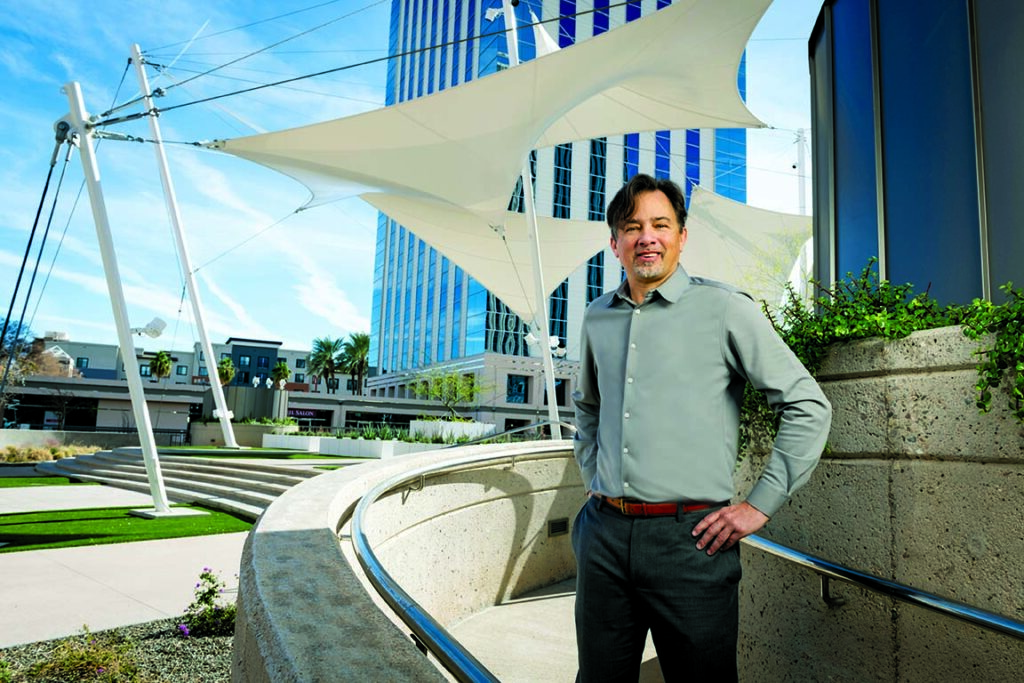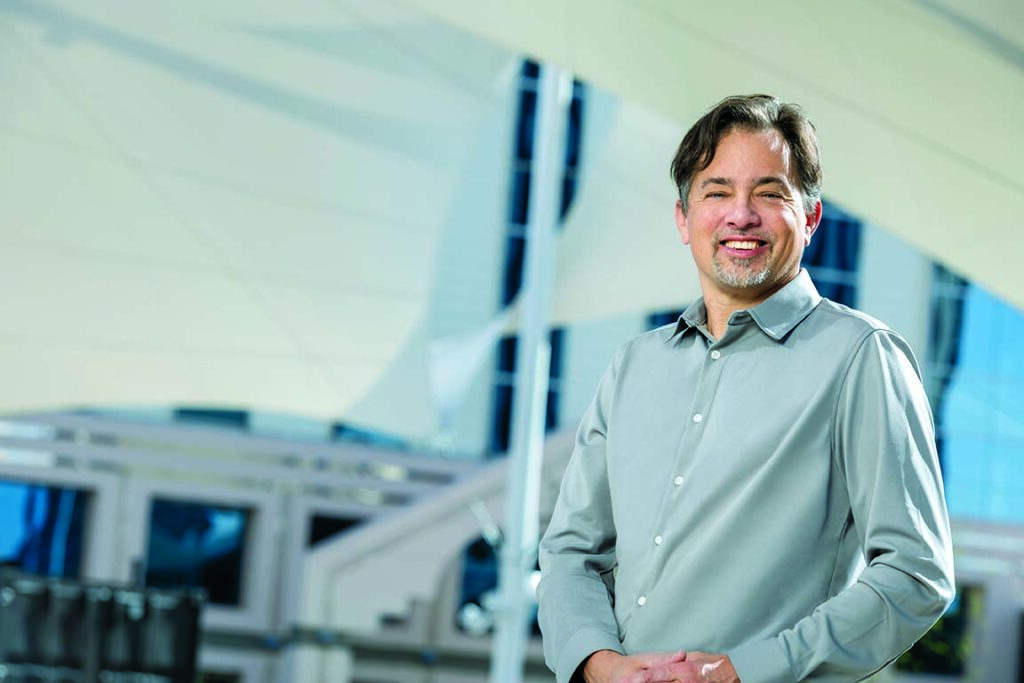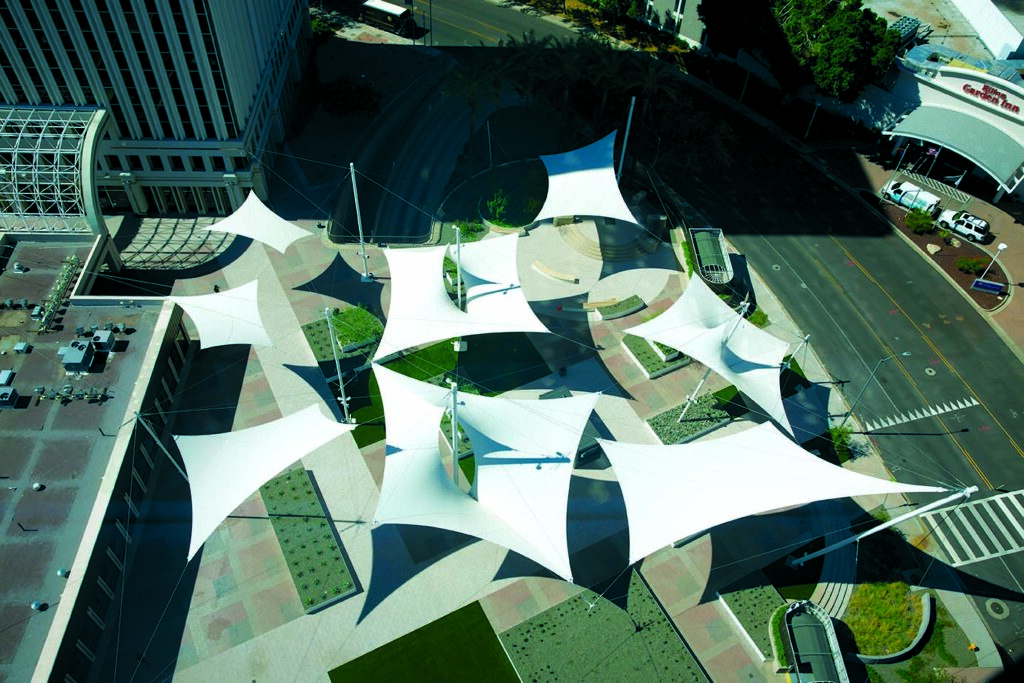
Growing up in Maryland, Mar Ricketts liked flying kites and architecture, two interests that continue to influence him today.
Ricketts is the principal and founder of GuildWorks LLC, a full-service design, specification, fabrication and installation company that creates permanent and temporary tension and fabric structures.
As unlikely as it may seem, the Portland, Ore.-based company owes its genesis to kites, which were the company’s first product when it was founded in the mid-1990s.
“A lot of them were control kites—performance kites so that groups would perform music with them,” Ricketts says. “I developed and marketed an indoor kite that basically doesn’t use wind.”
Kite and tension/fabric structures share some common elements.
“The base structural concept in a kite is for a tension-suspended air foil,” he says. “You can make a flight-efficient kite by the way the fabric is tensioned. It is a natural correspondence to fabric structures and fabric shapes. I applied fabric structures and lightweight structures to kites and saw opportunities for aerodynamics with them.
“Kites taught me how to build really strong lightweight fabric structures,” he adds.
The company sold kites to Cirque du Soleil and other theatrical groups, which led to requests for GuildWorks to create backdrops for performances and special events and eventually led to its current focus on permanent fabric structures.
“We started getting asked, ‘Could you create a backdrop for our corporate event or special event?’ Or ‘Can you change this space or protect it from the weather?’” Ricketts says.
Today, the company’s applications include plazas, courtyards, building entryways and spaces between buildings; civic, park and open-air structures; ETFE structures (an alternative to glass); pavilions and amphitheaters; fabric facades on buildings; interior spaces and public art.
As the company progressed, it moved from Massachusetts to Wisconsin and finally to Oregon, and evolved from producing kites to building temporary structures and then to building both temporary and permanent structures, but with more emphasis on permanent structures.
The move to permanent structures was intentional
“Starting about a decade or a little more ago, we started really focusing on ‘How do we work more in permanent structures?’” Ricketts says. “We wanted to do structures that stay up year-round, that have longer life cycles, that have a greater impact on people’s everyday lives and are more sustainable.”
Ricketts wants to push the envelope when it comes to the design of permanent structures as well, and he has the background to do just that. He studied engineering and architecture at the Pratt Institute in New York.
His interest in architecture was fueled in his boyhood when he designed a house that his family built.
“I spent my grade school years thinking about plans for a house that we would build as a family,” he says. “I was the one who drafted out the house that my parents had built by a builder. I got the builder and engineer to come on board. I drafted all of the construction documents.”
The experience offered insights.
“I had this architecture education by kind of living through it for years—the design of a structure and how it gets built,” Ricketts says. “I saw the experience from the client side and the architect side, even though we didn’t use an architect.”
The experience also prepared him to delve into and study different forms of architecture, such as lightweight structures.
Similar to when he designed his family’s house, the desire to create innovative, impactful, permanent structures continues to drive Ricketts’ work today.
“Architecture defines a space,” he says. “If you are on a field, you are just on a field and it may not be a defined space. But if you surround that field with parts of an architecture, you feel contained. This becomes a space where music happens or where community happens. Creating those spaces is part of what we do.”
Today, the company employs between 20 and 25 people and measures success not by the number of customers it has, but by the scale, magnitude and permanence of the projects it does.

Redevelopment project
One of its high-profile projects involved taking part in redeveloping and refurbishing Riverfront Park Pavilion in Spokane, Wash., which was built in 1974 for the World’s Fair.
“The fabric had ripped off of it and it had been left as this dead icon in the city for years,” Ricketts says.
GuildWorks worked for more than 18 months on the multi-million dollar project that required advanced engineering of the existing cable net structure and new tension elements that were incorporated to support an array of 72 custom-designed panels that provide shade and beauty to the new outdoor gathering and event space.
The project wasn’t easy.
“It took a huge amount of engineering work to figure out what was there and what it was,” Ricketts says. “In some ways, doing your own engineering work from the beginning is easier than figuring out how a very complex structure that is already there is working.”
Ricketts came away with great respect for the pavilion’s original engineers and builders.
“The fact that they built this 50 years ago without computers, but with slide rules and manual calculation is pretty impressive to say the least,” he says.
The distinctive shading array that GuildWorks constructed for the project has become an iconic image associated with downtown Spokane.
“You even see it printed for downtown Spokane’s iconography,” Ricketts says.
Even the pandemic that hit in March 2020 hasn’t slowed GuildWork’s growth, which Ricketts credits to the company’s newer focus on permanent projects.
“If we had been just an events company at that time, we would not be around now most likely,” Ricketts says. “We were fortunate in having so many permanent projects.”
While it still creates temporary structures, the company’s work is geared to creating projects that push the design envelope, are sustainable, bring communities together and leave a long-lasting impression.
“Temporary structures are a moment in time for events that last only a couple days or a week,” he says. “If people go to Spokane or if they live there, they see that structure in Riverfront Park or they know that structure. It has a lasting impact over time.”
Annemarie Mannion is a freelance writer based in Willowbrook, Ill.
SIDEBAR: Project Snapshot

Author, Author
Mar Ricketts looks forward to the day when the use of fabrics and membranes as building materials is commonplace. That’s one reason he wrote Visionary Building: Weave Technology & Natural Design to the Spectacular, scheduled to be released later this year.
“I think there is a missed point in the architecture field of not seeing membranes and fabrics used like glass, stone or wood,” he says. “It should be one of those standard materials out there.”
He wants to connect with audiences that can help make that goal happen.
“This book is kind of an inspiration,” he says. “It’s reaching out to developers, CEOs, CFOs and people who are investing in building and architecture and saying ‘Don’t feel like you have to build what’s being done everywhere else down the street. You can think about this differently.’”
He says he’s come to a time in his career when he can focus on what really matters.
“I feel like I’ve built a strong company and I am involved in it day to day,” he says. “But I am no longer the one doing the physical work anymore. I am thinking about how to leave a long-term impact. That’s a slow process, but this book is part of that.”
The book encourages decision-makers to tap into advanced technologies, such as fabrics that use sunlight and wind to create electricity, to push innovative design forward and to do amazing things.
SIDEBAR: Saving the planet
A desire to better protect the planet is a trend that Mar Ricketts sees more and more in the specialty fabrics industry.
“Our industry is starting to pay attention to environmental impacts and is in the process of changing,” he says. “I’m hoping to be one of the companies leading those changes.”
Ricketts says he’s recently seen more focus on sustainability and efforts to protect the environment at industry meetings.
“I’ve noticed a shift starting to happen,” he says. “At an industry trade show [in 2022], I gave a talk about sustainability and that [represented] a monumental jump. Go back a few years and not one of the talks was about sustainability. Now, every part of every day there was something that touched upon that subject line.”
He notes that advanced architectural fabrics can reduce heat island effects, collect water, filter pollution, regulate temperature and provide ample airflow.
The possibilities are exciting and Ricketts’ company, GuildWorks LLC, wants to be at the forefront.
“We are caring for the planet in the work we are doing,” he says. “We are not just doing the work to make money.”
 TEXTILES.ORG
TEXTILES.ORG


